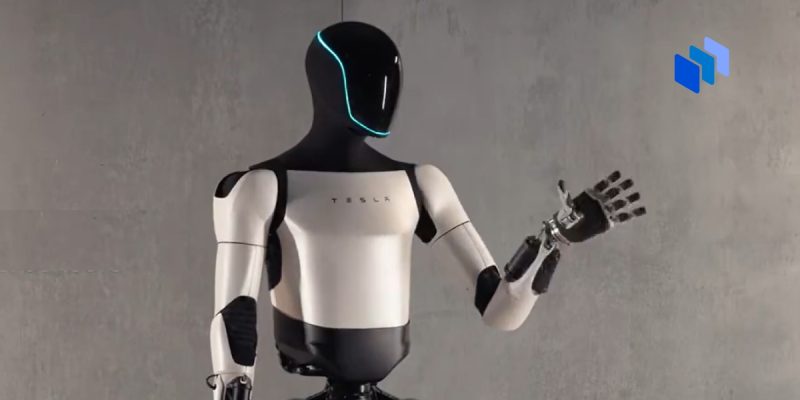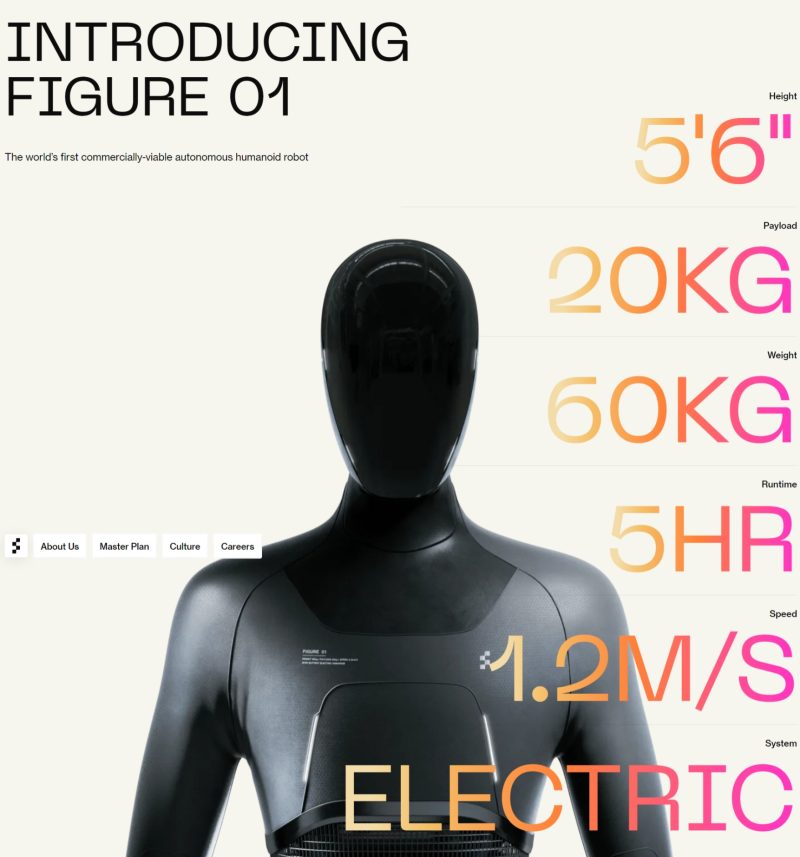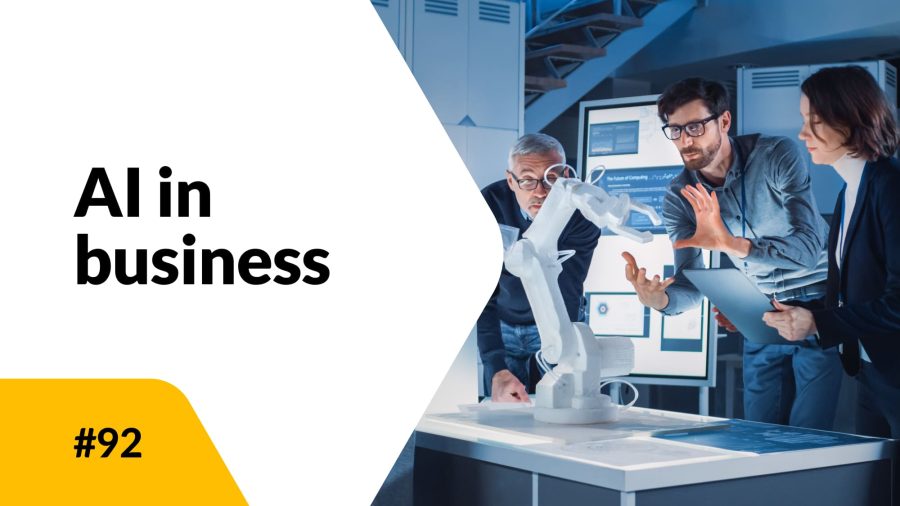AI robots - table of contents
How do AI robots change thanks
AI robots, thanks to advanced algorithms, are constantly evolving. Machine learning and deep learning enable robots to gain experience and expand their skill set. AI robots are also becoming increasingly efficient. Additionally, AI robots are able to:
- learn new skills autonomously,
- adapt to changing work conditions,
- optimize production processes in real time.
An example could be an industrial robot that, through the use of AI, autonomously detects anomalies in the production line and adjusts its working parameters to prevent downtime. It can analyze and adapt its actions to current production needs, resulting in increased efficiency and quality of performed tasks.
Tesla Optimus Gen-2
Moving on to specifics, the Tesla Optimus Gen-2 is an example of next-generation robotics where AI plays a key role. This machine exhibits capabilities that surpass previous expectations, such as sorting items or folding clothes. Elon Musk envisions Optimus handling a wide range of household and production tasks. With the use of innovative technologies like touch sensors in its fingers or advanced actuators, this robot is becoming increasingly autonomous and functional. It’s worth noting that Optimus Gen-2 is capable of:
- independent movement and manipulation of objects,
- performing complex movements such as squats, and even
- gently lifting very fragile objects, such as eggs, without causing damage.
The market for humanoid robots, including Optimus Gen-2, is growing at an incredible pace. According to statistics published by Markets and Markets, it will increase from $1.8 billion in 2023 to $13.8 billion by 2028.

Source: Techopedia (https://www.techopedia.com/tesla-optimus-gen-2-joins-the-world-of-ai-robots)
Figure, or BMW robots
In the context of the automotive industry, it’s worth mentioning the Figure robots used in the BMW factory. This is a great example of how AI robots can assist workers in their daily tasks.
These humanoid AI robots support workers in their daily tasks, such as sheet metal processing and warehouse logistics management. Their versatility and quick adaptation to various tasks are impressive.
They can use tools and methods just like humans, making them highly functional. The rapid development of these robots, resulting in walking prototypes within a year of starting work, is impressive.
It’s worth mentioning that Figure robots are used for tasks such as warehouse logistics. They are designed as multitasking devices. For example, the Figure 01 model autonomously made coffee in response to a voice command, showcasing its incredible learning capabilities.

Source: Figure.ai (https://www.figure.ai/)
Google Aloha
The Google Aloha project demonstrates how advanced AI algorithms can be used to accomplish complex tasks. Unlike Tesla’s and Figure’s projects, this system is based on off-the-shelf components and 3D printing technology. Therefore, it is an example of an economical approach to building complex robotic systems. It’s worth emphasizing that Aloha can:
- perform complex manipulation tasks – even as complicated as frying shrimps or opening kitchen cabinets,
- use existing data sets – this allows Aloha to increase the effectiveness of task execution,
- understand and predict human behaviors.
If you already see the use of this AI robot in your business, it is worth mentioning that the cost of building the Mobile Aloha system is $32,000.
Moxie, a robot for kids
Moxie is an innovative AI robot that helps children develop. It is an example of how AI robots can be used not only in business but also in education. Moxie helps children learn through play and develop social and emotional skills. Moxie’s key features include:
- Developing social skills – AI robot helps children learn empathy and build relationships.
- Supporting education –Moxie uses interactive stories and games to teach children new skills.
- Promoting healthy habits – the robot encourages daily affirmations and breathing exercises.
Each of these points underscores the importance of combining technology with human needs. For example, in the case of social skills development, Moxie can simulate conversations and situations that teach children how to interact with other people.
AI robots – the future in business
AI robots are already revolutionizing industries like manufacturing and warehouse logistics. Their impact on the industry is undeniable, and the future looks even more promising. In addition to the discussed examples from giants like Google and Tesla, AI robots also include:
- Forerunner from Kepler – an AI robot with exceptional precision, equipped with advanced actuators, sensors, and a versatile wide-angle camera,
- Digit from Agility Robotics – this is an example of a bipedal robot designed to work in warehouses and capable of navigating human spaces.
Each of these robots brings new possibilities to businesses, not only streamlining processes but also opening doors to new forms of collaboration between humans and machines. These robots will have an increasingly significant impact on our lives, both personally and professionally.
In conclusion, AI robots already play a crucial role in many business sectors, and their significance will continue to grow with technological advancements. They are no longer a futuristic concept but a reality that requires us to be flexible and ready for the changes they bring. For fledgling entrepreneurs, it’s important to keep track of the development of this technology and consider how they can leverage AI robots in their operations to gain a competitive edge and optimize processes.
If you like our content, join our busy bees community on Facebook, Twitter, LinkedIn, Instagram, YouTube, Pinterest, TikTok.
Author: Robert Whitney
JavaScript expert and instructor who coaches IT departments. His main goal is to up-level team productivity by teaching others how to effectively cooperate while coding.
AI in business:
- Threats and opportunities of AI in business (part 1)
- Threats and opportunities of AI in business (part 2)
- AI applications in business - overview
- AI-assisted text chatbots
- Business NLP today and tomorrow
- The role of AI in business decision-making
- Scheduling social media posts. How can AI help?
- Automated social media posts
- New services and products operating with AI
- What are the weaknesses of my business idea? A brainstorming session with ChatGPT
- Using ChatGPT in business
- Synthetic actors. Top 3 AI video generators
- 3 useful AI graphic design tools. Generative AI in business
- 3 awesome AI writers you must try out today
- Exploring the power of AI in music creation
- Navigating new business opportunities with ChatGPT-4
- AI tools for the manager
- 6 awesome ChatGTP plugins that will make your life easier
- 3 grafików AI. Generatywna sztuczna inteligencja dla biznesu
- What is the future of AI according to McKinsey Global Institute?
- Artificial intelligence in business - Introduction
- What is NLP, or natural language processing in business
- Automatic document processing
- Google Translate vs DeepL. 5 applications of machine translation for business
- The operation and business applications of voicebots
- Virtual assistant technology, or how to talk to AI?
- What is Business Intelligence?
- Will artificial intelligence replace business analysts?
- How can artificial intelligence help with BPM?
- AI and social media – what do they say about us?
- Artificial intelligence in content management
- Creative AI of today and tomorrow
- Multimodal AI and its applications in business
- New interactions. How is AI changing the way we operate devices?
- RPA and APIs in a digital company
- The future job market and upcoming professions
- AI in EdTech. 3 examples of companies that used the potential of artificial intelligence
- Artificial intelligence and the environment. 3 AI solutions to help you build a sustainable business
- AI content detectors. Are they worth it?
- ChatGPT vs Bard vs Bing. Which AI chatbot is leading the race?
- Is chatbot AI a competitor to Google search?
- Effective ChatGPT Prompts for HR and Recruitment
- Prompt engineering. What does a prompt engineer do?
- AI Mockup generator. Top 4 tools
- AI and what else? Top technology trends for business in 2024
- AI and business ethics. Why you should invest in ethical solutions
- Meta AI. What should you know about Facebook and Instagram's AI-supported features?
- AI regulation. What do you need to know as an entrepreneur?
- 5 new uses of AI in business
- AI products and projects - how are they different from others?
- AI-assisted process automation. Where to start?
- How do you match an AI solution to a business problem?
- AI as an expert on your team
- AI team vs. division of roles
- How to choose a career field in AI?
- Is it always worth it to add artificial intelligence to the product development process?
- AI in HR: How recruitment automation affects HR and team development
- 6 most interesting AI tools in 2023
- 6 biggest business mishaps caused by AI
- What is the company's AI maturity analysis?
- AI for B2B personalization
- ChatGPT use cases. 18 examples of how to improve your business with ChatGPT in 2024
- Microlearning. A quick way to get new skills
- The most interesting AI implementations in companies in 2024
- What do artificial intelligence specialists do?
- What challenges does the AI project bring?
- Top 8 AI tools for business in 2024
- AI in CRM. What does AI change in CRM tools?
- The UE AI Act. How does Europe regulate the use of artificial intelligence
- Sora. How will realistic videos from OpenAI change business?
- Top 7 AI website builders
- No-code tools and AI innovations
- How much does using AI increase the productivity of your team?
- How to use ChatGTP for market research?
- How to broaden the reach of your AI marketing campaign?
- "We are all developers". How can citizen developers help your company?
- AI in transportation and logistics
- What business pain points can AI fix?
- Artificial intelligence in the media
- AI in banking and finance. Stripe, Monzo, and Grab
- AI in the travel industry
- How AI is fostering the birth of new technologies
- The revolution of AI in social media
- AI in e-commerce. Overview of global leaders
- Top 4 AI image creation tools
- Top 5 AI tools for data analysis
- AI strategy in your company - how to build it?
- Best AI courses – 6 awesome recommendations
- Optimizing social media listening with AI tools
- IoT + AI, or how to reduce energy costs in a company
- AI in logistics. 5 best tools
- GPT Store – an overview of the most interesting GPTs for business
- LLM, GPT, RAG... What do AI acronyms mean?
- AI robots – the future or present of business?
- What is the cost of implementing AI in a company?
- How can AI help in a freelancer’s career?
- Automating work and increasing productivity. A guide to AI for freelancers
- AI for startups – best tools
- Building a website with AI
- OpenAI, Midjourney, Anthropic, Hugging Face. Who is who in the world of AI?
- Eleven Labs and what else? The most promising AI startups
- Synthetic data and its importance for the development of your business
- Top AI search engines. Where to look for AI tools?
- Video AI. The latest AI video generators
- AI for managers. How AI can make your job easier
- What’s new in Google Gemini? Everything you need to know
- AI in Poland. Companies, meetings, and conferences
- AI calendar. How to optimize your time in a company?
- AI and the future of work. How to prepare your business for change?
- AI voice cloning for business. How to create personalized voice messages with AI?
- Fact-checking and AI hallucinations
- AI in recruitment – developing recruitment materials step-by-step
- Midjourney v6. Innovations in AI image generation
- AI in SMEs. How can SMEs compete with giants using AI?
- How is AI changing influencer marketing?
- Is AI really a threat to developers? Devin and Microsoft AutoDev
- AI chatbots for e-commerce. Case studies
- Best AI chatbots for ecommerce. Platforms
- How to stay on top of what's going on in the AI world?
- Taming AI. How to take the first steps to apply AI in your business?
- Perplexity, Bing Copilot, or You.com? Comparing AI search engines
- ReALM. A groundbreaking language model from Apple?
- AI experts in Poland
- Google Genie — a generative AI model that creates fully interactive worlds from images
- Automation or augmentation? Two approaches to AI in a company
- LLMOps, or how to effectively manage language models in an organization
- AI video generation. New horizons in video content production for businesses
- Best AI transcription tools. How to transform long recordings into concise summaries?
- Sentiment analysis with AI. How does it help drive change in business?
- The role of AI in content moderation


















